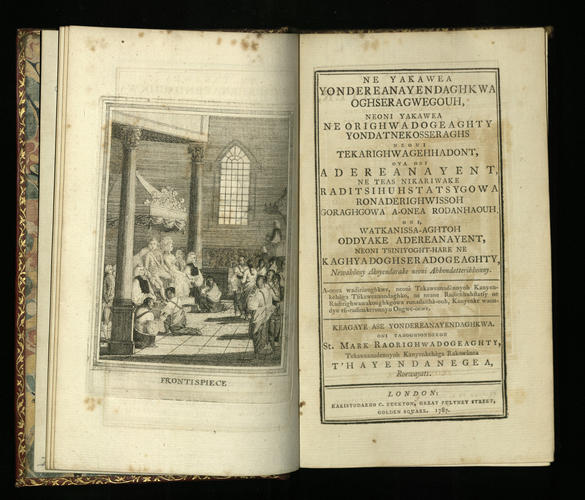The Book of Common Prayer translated into the Mohawk language 1787
22.5 x 4.5 cm (book measurement (inventory)) | RCIN 1054767
-
Like many Indigenous people who bordered European colonies in North America from the seventeenth century, the Mohawk (Kanien'keha:ka) had received missionaries who attempted to convert them to Christianity. By the eighteenth century, many Mohawk had adopted the Christian faith from repeated English missions and translations of the Book of Common Prayer became a way to allow people to practice the religion in their own language, to understand church services that were primarily delivered in English and to facilitate communication between Mohawk and English traders.
This 1787 edition of the Book of Common Prayer also included, for the first time, the full text of the Gospel of St Mark in the Mohawk language. The translation was made by the Mohawk leader Thayendanegea, also known by his Christian name, Joseph Brant (1743–1807). Both parts had a parallel text in English and in Mohawk while the Gospel also contained etchings illustrating the most important moments of the life of Jesus Christ.
Brant had travelled to London in 1775 where he met political figures and had an audience with George III at St James's Palace. Part of the visit was to negotiate Mohawk support for Britain in the American War of Independence.
In 1784, Brant moved his people from their homes in New York to new land in Canada (near Brantford, Ontario) and in 1785, he returned to London, where he had another audience with the King and was entertained by the Prince of Wales (later George IV). According to Brant's biography by William Stone (1792-1844), it was on this visit that he finished the translation of the Book of Common Prayer he had started before the war (Life of Joseph Brant-Thayendanegea, vol. 2, New York, 1838, pp. 260-1; RCIN 1026171). The completion of the translation was undertaken with George III's patronage so that it could replace earlier translations that had been lost during the conflict. The project was supported by the Society for the Propagation of the Gospel in Foreign Parts, but the typesetting and printing of the book was supervised by Brant to ensure that the Mohawk text was accurate. An engraving depicting Brant's meeting with the King and Queen was used as the frontispiece to the published work. It was probably at the same meeting that the King granted the Mohawk a chapel in gratitude for their assistance in the war. This church was the first Anglican church to be built in Canada. It was designated a Chapel Royal by King Edward VII in 1904.Provenance
From the library of George III at Windsor
-
Creator(s)
(corporate author)(illustrator)(printer) -
Measurements
22.5 x 4.5 cm (book measurement (inventory))
Category
Other number(s)
ESTC : English Short Title Catalogue Citation Number – ESTC T52851Alternative title(s)
The Book of Common Prayer.. translated into the Mohawk language.. a new ed. / by Capt. Joseph Brant
The Book of Common Prayer and administration of the Sacraments and other rites and ceremonies of the Church according to the use of the Church of England : together with a collection of occasional prayers and divers sentences of Holy Scripture necessary for knowledge and practice ; A new edition : to which is added the Gospel according to St Mark, translated into the Mohawk language / by Captn. Joseph Brant, an Indian of the Mohawk nation.
Ne Yakawea Yondereakanayendaghkwa Ogserawegouh, neoni Yakawea ne Orighwadogeaghty Yondatnekosseraghs neoni Tekarighwagehhadont oya oni Adereanayent ne teas nikariwake raditihuhstatsygowa ronaderighwissoh goraghowa a-onea rodanhaouh oni, watkanissa-aghtoh Oddyake Adereanayent, neoni tsniyoght ne Kaghyadoghseradogeaghty, Newahoeny Akoyendarake neoni Ahhondartterihhonny ; Keagaye ase Yondereanayendaghkwa oni Tahoghsondero St Mark Raorighwadogeaghty / tekaweanadennyoh kanyenkehaga rakowanea T'hayendanega, Roewayats.
Indian Prayer Book [Historic title on spine]









